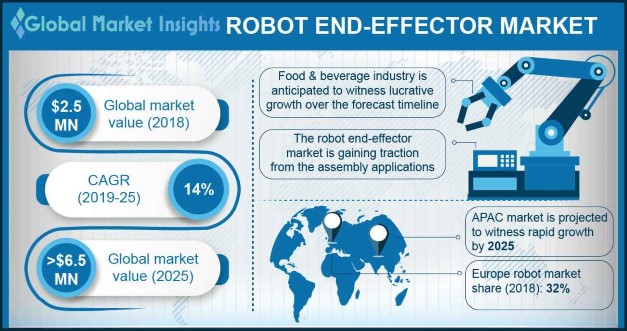Home > Semiconductors & Electronics > Automation > Robotics > Robot End-Effector Market
Robot End-Effector Market Size
- Report ID: GMI4286
- Published Date: Aug 2019
- Report Format: PDF
Robot End-Effector Market Size
Robot End-Effector Market size exceeded USD 2.5 billion in 2018 with around 14% CAGR estimation from 2019 to 2025. The global unit shipment is expected to grow at a CAGR of over 22% from 2019 to 2025.
The growing adoption of robots in assisting and performing a number of tasks, such as machine handling, welding, household works, and others, is one of the key factors driving the growth of the robot end-effector market. End-effectors include all devices, which are installed or connected at a robot wrist which interact with the work components or parts to perform a particular task. For instance, the welding torch is used at the end of the robot arm for welding a given component. In addition, the increasing deployment of robots for pick and place operations in logistics industry, palletizing, casting, arc welding, material handling and other applications, the demand for end-effectors have grown significantly.
| Report Attribute | Details |
|---|---|
| Base Year: | 2018 |
| Robot End-Effector Market Size in 2018: | 2.5 Billion (USD) |
| Forecast Period: | 2019 to 2025 |
| Forecast Period 2019 to 2025 CAGR: | 14% |
| 2025 Value Projection: | 6.5 Billion (USD) |
| Historical Data for: | 2014 to 2018 |
| No. of Pages: | 215 |
| Tables, Charts & Figures: | 343 |
| Segments covered: | Product, Application, End-Use and Region |
| Growth Drivers: |
|
| Pitfalls & Challenges: |
|
With the rise of the collaborative robot market, the market for end of arm tooling is projected to further observe greater demands as these robots require more sensors integrated on them to work effectively in a human-robot work environment ensuring safety and security of humans. The advancements in sensor technology have made it possible for these robots to work without the requirement of any custom software. These robots are far more proficient compared to the bulky industrial robots and are increasingly being deployed in manufacturing and supply chain distribution.

